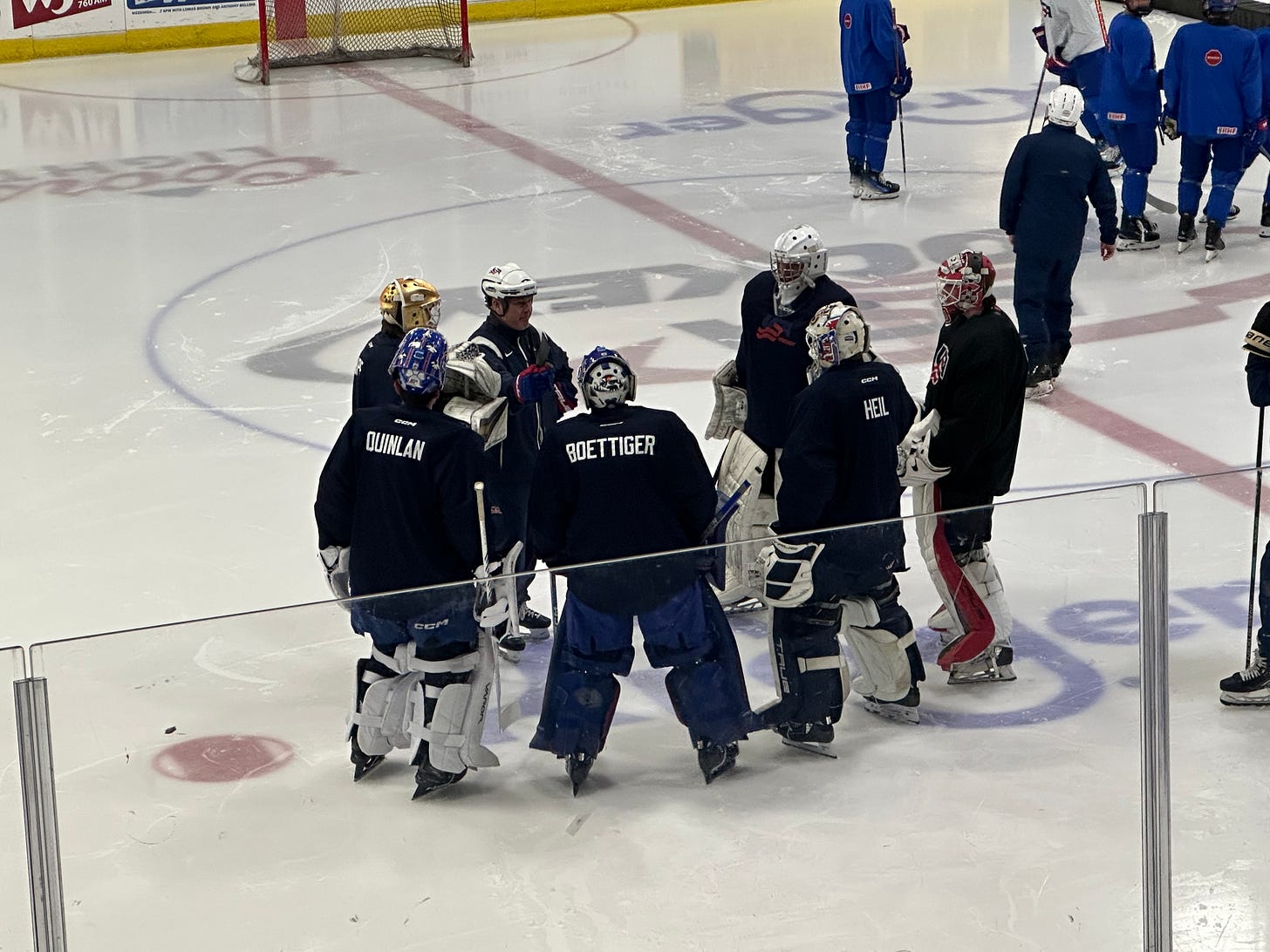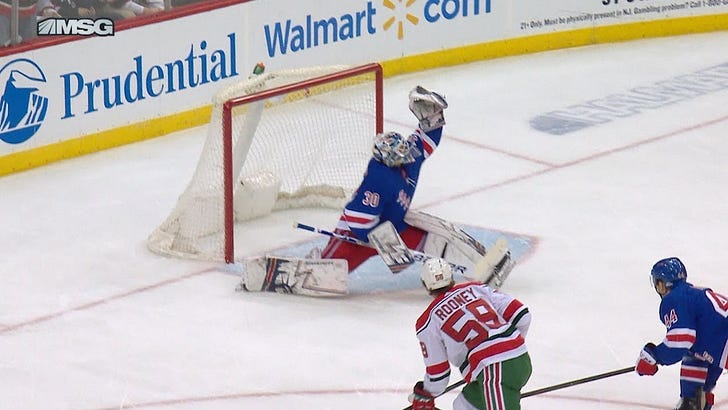Why early specialization and adult-sized nets have hurt goalie development
We continue goalie week coverage with a conversation about how the game is played at the youth levels.
Yesterday we went deep into the weeds on a very specific, nuanced topic.
How catching pucks has become a lost art for goaltenders, not just at the NHL level, but how it starts with minor hockey and younger goalies copying their idols and potentially using the wrong equipment.
When working on that piece, I initially thought I would dive deeper into the notes about single-sport specialization, which Bill Ranford opined about in his podcast appearance.
And while single-sport specialization might be hurting goalies ability to catch pucks, I’m sure playing baseball would help that eye-hand coordination and watching the puck into the glove, it seemed a bit more anecdotal and less fact-based than the equipment discussion we ultimately had with USA Hockey’s Manager of Goaltending Steve Thompson and Dallas Stars goalie Jake Oettinger.
Single-sport specialization is also more of a universal problem than a goaltending one. With the monetization and business-driven nature of youth sports now, families and kids are forced to pick one sport earlier and earlier.
When it comes to hockey, I always think about what former Dallas Stars forward, and current Chicago Blackhawks forward, Jason Dickinson told me when he had to have hip surgery. He believed that his hips had worn down as quickly as they did, in his early 20s, because he never stopped skating as a kid, never took time off from hockey. He said it helped him reach the NHL, but overuse led to surgery that should be now normal for 20-something athletes.
It’s the same case in baseball with pitchers, in fact one of my favorite books on the subject is The Arm by Jeff Passan, how overuse and specialization have led to common injuries that shouldn’t be this common.
Anyways, to get us back to goaltenders and goalie development, one of the things that Thompson spoke about was how goalie specialization within hockey is hurting the sport.
According to Thompson, and USA Hockey is hoping this becomes the norm, youth teams should do their best to carry multiple kids that play goalie and skate out, frequently changing them in game, between periods, so multiple athletes get a chance to learn the position.
“You should slowly increase the time for those goalies as they get older, but you shouldn’t be cutting kids or ever shoving them away from the position. We have that a lot where communities with teams and there’s five kids at tryouts for 8U or 10U and they only choose one goalie, and then maybe those other four stop playing,” Thompson said. “Then three years later that one kid that everybody’s been investing in, because they are so adamant they have to win 10U tournaments, maybe moves because the parents got a new job or they go to another team. Or that goalie likes soccer more and quits hockey, and now the community has its arms up in the air because they don’t have any goalies left. Well of course you don’t have any goalies left, you cut every kid you thought wasn’t good enough to win the 10U championship.”
Thompson pointed to Anders Miller as an example of how this can work positively.
Miller grew up playing both goalie and skater in Alaska, he didn’t become a full-time goalie until he was 12-years-old, and now as an 18-year-old started in the WHL playoffs for the Calgary Hitmen.
Miller wasn’t the best goalie growing up, he could have been pushed away from the position and told to skate out. Instead he was able to play both, became a better skater and athlete. Miller also said part of his play reading and success now is a byproduct of him understanding the game as a skater, too.
“There’s lots of ways that these late-blooming kids, especially goalies, need to be Abel to come into their own at 15, 16, 17-years-old, but it only happens if we continue to provide resources and keep your goalie pool up,” Thompson said. “It’s why at any age, you really have to discourage any team from having one goalie — and many youth teams do — it’s not good for them, it’s not good for you as a coach. Your practice design is terrible with one goalie, the work ethic and practice is going to be diminished and the goalie ends up just surviving the season instead of growing and reflecting or executing their game.”
Thompson said ideally more teams at that teenage level, once goalie specialization has happened, would carry three goalies and ideally the coaches would look at that as a strength, a chance to play all three and grow three athletes, as opposed to a turning one only into a practice goalie.
The other thing about goalie development, which I wanted to ask Thompson about was net size and skater skill. How with the popularization of individual skills training for skaters has made lacrosse-style moves — I call it the Legger, by the way — more common at youth games.
It’s pretty common now for some 10-year-olds to pick up the puck lacrosse style, which is fancy and all, but when they’re putting the puck into the upper corner of a net against a 10-year-old goalie who can’t reach the crossbar, it’s not really a hockey play, is it?
“That’s one of the reasons we really shouldn’t be using an adult net until 12 or 14 at the earliest,” Thompson said. “From a player development standpoint it’s teaching goalies some selections that are not necessarily representative of the save selections we want to see them making when they get older. So you shrink the net down and it forces players to work on more skill, to find the areas of the net and actually aim instead of just throwing it high because youth goalies can’t cover the top of a big net.”
Right now USA Hockey recommends a 48-inch net at 8U and a 52-inch net at 10U.
“Also from a goalie perspective, it’s going to allow the goalies to have some more success, which is really helpful for kids still wanting to try the potion when we have large attrition rates,” Thompson added. “It’s not supposed to be kids in goalie pads trying to make soccer saves, and hopefully as we work on things with USA Hockey that becomes more and more of the norm with the right size nets at rinks across the country.”




When coaching Mighty Mites, 5-6 yrs old… after our season, I had a Dad come ask me what I was doing with my son for his hockey over the summer? I said, “nothing”, just running around with his friends, riding his bike, just being a 5 yr old! (No video games, no motorized cars, but that was easier 20 yrs ago!).
Early specialization is the ruination of many promising athletes. Ask Cal Ripken. They miss out on other muscle skills. They, as you mentioned, get overuse injuries, lifelong injuries! And worst of all, they burn out. Turning away from what could have been a lifelong passion.
Unreasonable dreams of parents that their kid will be “one in a million”, is one cause. Acceptance of the bs that if my kid isn’t on “this team” or “that tournament” he won’t get noticed. Again, utter bs. Jamie Benn got noticed. Played 2 sports until Major Junior. Talent will get noticed… and it will rise even without the extra coaching, the extra exposure, oh yea the extra cost$$$.
People making money off the unrealistic dreams of children are NOT in it for the love of the game, if they perpetuate unrealistic expectations for $.
We just did our first year of 10U and I think it’s crazy that they go from the 8U n
Nets straight to the big nets.